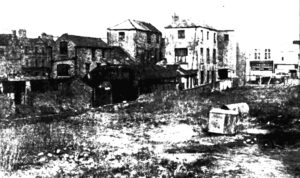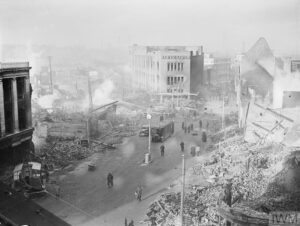Bingo Heroes: Arthur Charles Bannington
One of the earliest and best descriptions of Bingo was written by Arthur Charles Bannington. In the First World War, he joined the Motorised Machine Gun Corps (later the Tank Corps) and was at Ypres and Cambrai. His description of Bingo, or House as it was called then, was published in a Coventry newspaper in 1917 while he was still serving on the front line.1
First to State Zero Numbers are Blind

Arthur Charles Bannington, from his 1918 Election Leaflet
He is the first to state that numbers ending in zero are called ‘blind’ and to explain why nicknames are used:
“To prevent eleven being confused with seven he calls out for eleven’ legs eleven,’ and to make the numbers 20, 30, 40, 50, 60 clear he calls ‘blind 30,’ ‘blind 40,’ ‘blind 60,’ etc.”
“For 66 he shouts ‘Clicketty-click’; for one, ‘Kelly’s eye.’ For 90, which is the highest number on the cards, he calls ‘Top of the house’ or ‘Top of the cabboose,’ and for No. 9 some say ‘Medicine and duty,’ which has its origin in the of fact that for minor ailments of the men reporting ‘sick’ the M.O.’s [Medical officer] invariable remedy is one or two No. 9 pills.”1
Bannington also provided a valuable insight into how numbers were called:
“It is very interesting to watch the game and to note the facial expression. The “caller” starts of calling; usually long practice (possibly in the meat or fish line) has developed his voice, and with a drawling, deliberate raucous voice and a drop in his tone at the end of every fifth or sixth number he begins: Num-ber sev-ern, Kel-ly’s-eye, fo-orty three, blind sixty, fifty hate, foorty noine, blind hatey, medcine and dooty, fo-orteen, click-etty-click, blind thirty, top o’ th’ house, noin-toen, and so on until some lucky one yells “house,” and simultaneously a number of the less fortunate ones who “‘ave jest one blinking number to fill,” fill the air instead with a ruddy bluish mixture or vapor. Meanwhile one of the gang has called out the winner’s or the claimant’s number to the caller and verified them and paid out.1
Committed Socialist

Bannington’s faked image showing a bombed Coventry from his 1918 election campaign.
Bannington was a committed socialist who was a Labour Councillor on Coventry Council and contested the Parliamentary elections in both Carlisle and Conventy.2
Coventry’s first Socialist councillor
In 1905, he won a seat in All Saints’ ward and became Coventry’s first Socialist councillor. He had a wide circle of acquaintances, was a Friend of leading socialists at the time, including George Lansbury, Ben Tillett, as well as Eleanor Marx, daughter of Karl Marx.2
Due to his connection with the Socialist Democratic Party, the Coventry Labour organisation withdrew support from him in 1908, and in 1909, he lost his seat on the Council.2

Air-Raid Damage in Coventry, Scenes of damage in and around the cathedral and the centre of the city. The Pioneer Corps assisted in clearing the debris. Taken by Lieutenant Taylor, 16th November 1940, Copyright IWM (H 5600)
1918 General Election and a Prophetic Prediction
As the Soldiers’ and Sailors’ candidate for the 1918 Coventry elections, he stressed the need to thoroughly deal with the Germans after the horrors of the First World War, and he had a fake picture published showing a bomb-wrecked Broadgate area of Coventry.2
Whilst prophetic, the image proved unpopular, and Bannington ultimately placed 4th in the election. Yet, some 22 years later, on the night of 14th and 15th November 1940, in what was the single most concentrated air raid on a British city during the Second World War, his prophecy was proved right.3
Bannington was a keen watercolour artist and gifted wood carver, and was responsible for replacing some of the old carved pews in the Cathedral.2
Special thank you to John C. Hewitson, Archives Assistant, Coventry Archives, CV Life, www.cvlife.co.uk, for help with this article.



Leave A Comment